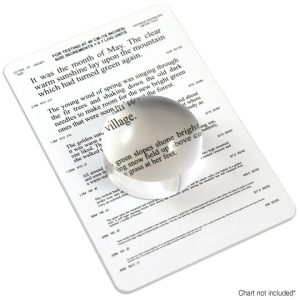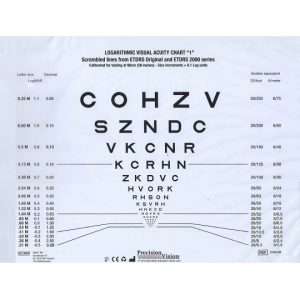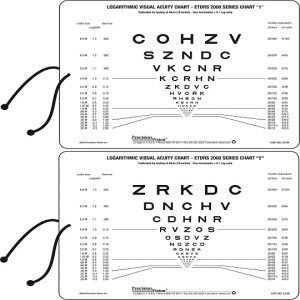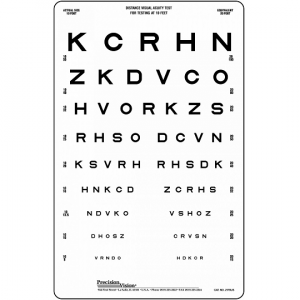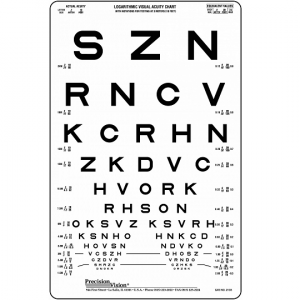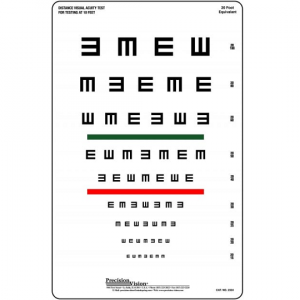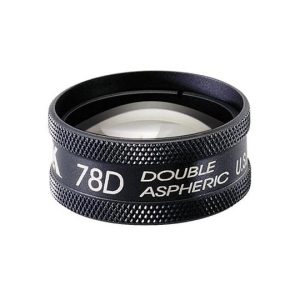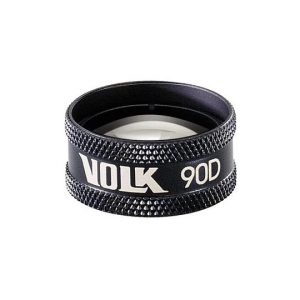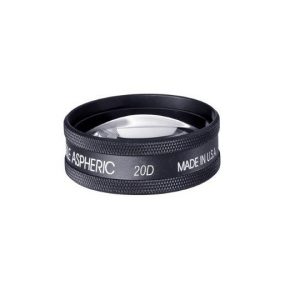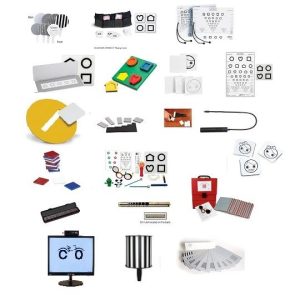Showing 529–552 of 1193 results
-
-
Vectograms, Stereo Acuity Test
Fixed Vectogram Acuity Suppression
Fixed Vectogram
Acuity Suppression Vectogram4″ x 5-1/2″ Non-Variable
Polarized vectograms ensure testing and training at actual distances. Vectograms stabilize fusion and stereopsis, eliminate suppression and develop simultaneous vision.
SKU: SOV9 -
-
-
Contrast Sensitivity, Near Vision Chart, Near Vision Charts, Ophthalmic Clinical Research
MNRead Chart 1 In English Black Background
 Contrast Sensitivity, Near Vision Chart, Near Vision Charts, Ophthalmic Clinical Research
Contrast Sensitivity, Near Vision Chart, Near Vision Charts, Ophthalmic Clinical ResearchMNRead Chart 1 In English Black Background
The MNREAD Acuity Charts are continuous text reading acuity charts for normal and low vision.
Often times traditional vision charts only measure general parts of normal vision, such as acuity and contrast. However, many times everyday life scenarios place these two aspects in unique situations. For example, acuity is very important in vision. Testing acuity normally involves a standard eye test. However, when reading the newspaper, the eyes are challenged by small print, continuous text, and several close contact lines. This basic living situation may cause problems for patients with scotomata and may not be detected on conventional acuity charts. Continuous text charts give one more possibility during vision testing.
SKU: C405 -
Pediatric Opthalmology, Low Contrast, Low Contrast & Low Vision Charts
Tumbling E Flip Book
Notations in M letter sizes ranging from 20M to 1.6M for testing at various distances. Each page it’s own contrast level at 100%, 2.5% and 1.25%. This flip book is great for vision studies and research world wide. The Tumbling “E” vision chart uses only one
optotype
for testing. Patients not familiar with the Roman alphabet simply have to gesture or sign which direction they see the “E” facing. This is a helpful test for patients that are illiterate or mute, also. This Tumbling “E” flip book contains three contrast levels for accurate sensitivity screening.
SKU: 2380 -
-
Ophthalmic Clinical Research, Near Vision Chart
Bangerter Occlusion Foil 20 20 1.0
May be used as a preventative measure for amblyopia, suppression and abnormal retinal correspondence. Used therapeutically in the treatment of amblyopia, orthoptic treatment, diplopia, diplopia with monocular aphakia (with <0.1). May be used as a primary treatment or as alternative treatment in cases where patching therapy is no longer providing further benefits.
SKU: C2020 -
Contrast Sensitivity, Distance Charts
Mars Contrast Sensitivity Test Numbers
Numerals are universally used in cultures all over the world. The Mars Numeral Contrast Sensitivity test version, which functions identically to the Mars Letter Contrast Sensitivity test, is intended for use where patients and clients might be less familiar with the letters of the Western alphabet. The ten numerals in this test are designed with the same geometric principles as the ten Sloan letters, making scores easily compared to those of the Mars Letter version. Hand-held, with quick, simple and convenient scoring. Three chart forms in protective sleeves, user manual and storage case.
SKU: 5019n -
Ophthalmic Clinical Research, Intermediate charts
Near or Intermediate Vision Chart
Near at 40cm Testing Distance
Intermediate at a Choice of 66cm, 67cm, or 80cm Testing Distances.All with Cord for easily achieving proper testing distance.
Near Vision Testing at 40cm: 8M (20/400) to .20M (20/10)
Intermediate Vision Testing at 66cm: 8M (20/250) to .20M (20/6.3)
Intermediate Vision Testing at 67cm: 13.4M (20/400) to .34M (20/10)
Intermediate Vision Testing at 80cm: 16M (20/400) to .40M (20/10)
Memorization can alter testing results and create an inaccurate record for the patient. This near vision chart features multiple groups for repetitive testing help minimize memorization. This helps to create a more accurate and reliable vision chart that yields repeatable results.
Each side is different to minimize memorization.
Available
optotype
s and formats include:
Lighthouse Sloan: Standard Near 40cm
Sloan ETDRS: Standard Near 40cm, Intermediate 80cm, Intermediate 67cm, Intermediate 66cm, Intermediate 60cm, Near 33cm
HOTV: Standard Near 40cm, MassVat
Landolt C: Standard Near 40cm
Patti Pics: Standard Near 40cm, MassVat
PV Numbers: Standard Near 40cm, MassVat
SKU: n/a -
Contrast Sensitivity, Near Vision Charts
Near Point Acuity Illuminated Flip Chart
Logarithmic Progression using ETDRS Chart 1 and ETDRS Chart 2.
Size increments = 0.1 LOG Units.
Features notations for Letter Size, Decimal, Meters, Feet, and Diopters of Add.
Mask included for concealing bottom portion of the chart while using the top for testing.
Near vision test uses the same format as ETDRS 2000 series charts. ETDRS format is calibrated for reliable, repetitive testing using equal difficulty and geometric progression. Vision test uses Sloan
optotype
s for equal difficulty from
optotype
to
optotype
and from line to line creating a uniform level of difficulty. This test features two different ETDRS style permutations for repetitive non memorized testing for both eyes.
SKU: 2199 -
Pediatric Opthalmology, Distance Visual Acuity Test
Proportionally Spaced Translucent Sloan Vision Chart
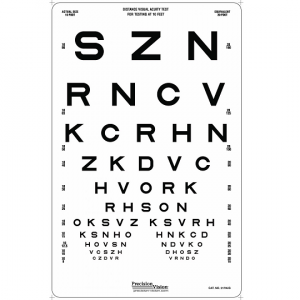 Pediatric Opthalmology, Distance Visual Acuity Test
Pediatric Opthalmology, Distance Visual Acuity TestProportionally Spaced Translucent Sloan Vision Chart
Two smaller groups 10/20 to 10/8 for repetitive eyesight testing (20/40 to 20/16 equiv.).
Can be wall-mounted.
This translucent eye chart uses Sloan
optotype
s for accurate testing. Each
optotype
has been calibrated for size, difficulty, threshold blur, and dimension. Each line is arranged equally. This eye test also includes two smaller groups for repetitive testing without memorization.
SKU: 2179US -
Pediatric Opthalmology, Distance Visual Acuity Test
Linear Spaced Translucent Sloan Vision Chart
Two smaller groups 10/25 to 20/8 for repetitive eyesight testing (20/50 to 20/16 equiv.).
Can be wall-mounted.
Sloan
optotype
s were developed by Louise Sloan in 1959. She developed a set of 10
optotype
s that had the same basis as the Snellen
optotype
s, the 5×5 grid. However, Sloan
optotype
s do not use serifs and use a geometric progression. This Sloan chart still uses Snellen equivalents and is calibrated for testing at 10 feet.
SKU: 2178US -
Pediatric Opthalmology, Distance Visual Acuity Test
Logarithmic SLOAN Visual Acuity Test
Two smaller groups 6M to 1.5M for repetitive testing (20/40, 6/12 to 20/10, 6/3 equiv.).
Can be wall-mounted.
Includes LogMar and Letter sizes on chart.
Logarithmic chart uses traditional Sloan
optotype
- These calibrated
optotype
s blur at threshold and adhere to the Snellen 5×5 grid. Sloan chart uses two smaller groups for repetitive testing and minimizes memorization. Logarithmic Sloan acuity test is a great screener for literate adults and children.
SKU: 2103 -
Pediatric Opthalmology, Distance Visual Acuity Test
Tumbling E Visual Acuity Color Vision Screening
Red and Green color bars for an easy and helpful place to start administering the test.
Tumbling or Illiterate E charts have one of the best visual acuity thresholds among alternate symbol acuity tests. Tumbling E tests are considered comparable to Landolt C tests which are considered the basis of alternate symbol tests. Great for the detection of Astigmatism.
SKU: 2324 -
Pediatric Opthalmology, Distance Visual Acuity Test
Traditional Tumbling E Visual Acuity Chart
Can be wall-mounted.
Traditional design.
Great for vision screening in multiple languages.
Helpful 20 foot equivalents.
The Tumbling E test uses a single
optotype
, the E in four different positions; up, down, left and right. By using a single symbol
optotype
, this eye test can be administered to several different groups of people, including children, illiterate adults, non-speaking adults, and patients not familiar with the Roman alphabet. The patient will only have to signal which direction the E is facing.
SKU: 2310US -
Contrast Sensitivity, Accessories CSV 1000 & 2000
Floor Stand with Casters
A floor stand with casters used with either the ESV3000 & ESC2000 ETDRS, illuminated cabinet, or the CSV-1000 Instrument.
The base of the stand measures 27.5″ square (69.85 cm). The height is adjustable from a minimum of 33″ (83.82 cm) to a maximum of 49″ high (124.46 cm).
SKU: 500004 -
Vision Therapy, Lens
Volk 78D Lens
The is an ideal lens for doctors who regularly cater to populations prone to glaucoma and other posterior pole abnormalities. The double aspheric design and field of view offered by a 78D offers clear and large views of the central mid-retinal regions. This lens offers a high magnification without cutting down too drastically on the field of view. This lens is a popular choice as a general diagnosis lens among doctors who prefer a larger ring size than the more common and smaller profile of the 90D. Dilation is required to obtain optimum retinal imaging with the 78D.
SKU: V78LC -
Vision Therapy, Lens
Volk 90D Lens
The Volk 90D is the most widely known fundoscopy lens and is to date considered the gold standard in exam rooms across the world. The small profile of the 90D coupled with its optical profile makes it a great first lens. This lens is a perfect choice for general examination and retinal imaging. This lens can be used to get through small pupils for patients who do not prefer or accommodate dilation and as a result is also a popular choice for undilated retinal exams.
SKU: V90C -
Vision Therapy, Lens
Volk 20D Lens
Perhaps the most recognized lens around the world, the Volk 20D is the lens that started the legacy of double aspheric lens design for BIO and is still considered as a gold standard. The contributing factors for this are the perfect balance of field of view and magnification of the 20D. The working distance of 50 mm also makes lens manipulation a comfortable experience for the examiner. This lens is perfect for general diagnosis of patients with a 3x magnification and field of view that allows visualization up to the mid peripheral region. The dynamic examination with the appropriate eye movements by the patients allows viewing of the peripheral retina as well as detailed examination by BIO in the primary position provides a comprehensive estimate of retinal health. Thus, this lens is a great choice both as a first line of diagnosis as well as a high level central retinal examination.
SKU: V20LC






